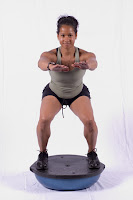Last month I showed you the second step in a balance training regimen–the one-legged balance. You’ll want to practice this on its own, as well as with a little challenge, to stimulate your proprioceptive system enough to prepare you for the third step–the rocker board.
Rocker boards can be purchased online or from your local neighborhood (Beverly Hills) sports chiropractor. A rocker board is a flat surface sitting on top of an angled fulcrum (30 degrees usually). It creates instability in one plane, either forward/backward, diagonally or side-to-side depending on how the board is turned relative to the person. Each plane adds a unique challenge to the balancer, and mastering all three planes, both with two legs and on single legs, is necessary to move onto the next level–the wobble board.
 Once again, it’s important to have a friend challenge you by tossing an object (ball, chainsaw, feral cat) back and forth with you as you balance. Not only is balancing on one leg a phenomenal challenge, but transitioning from one leg to the other should also prove demanding. Once you sufficiently master the rocker board, you can graduate to the wobble board or Bosu ball which are unstable in every plane, and thus significantly more difficult.
Once again, it’s important to have a friend challenge you by tossing an object (ball, chainsaw, feral cat) back and forth with you as you balance. Not only is balancing on one leg a phenomenal challenge, but transitioning from one leg to the other should also prove demanding. Once you sufficiently master the rocker board, you can graduate to the wobble board or Bosu ball which are unstable in every plane, and thus significantly more difficult.
Proprioceptive training is not only for balance but also for motor coordination, proper weight distribution and core strength; it helps elderly people to prevent falls (which can lead to fractures and even death); it’s great athletic training; and it’s imperative for rehabilitation from serious injuries. I encourage everybody to take on a balance training regimen for health and function.
Watch the video below for a demonstration on using the rocker board, as well as tips on how to challenge yourself while balancing. Keep rocking!












